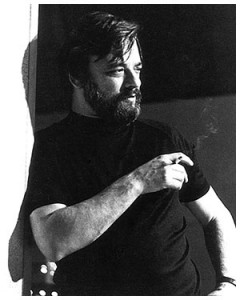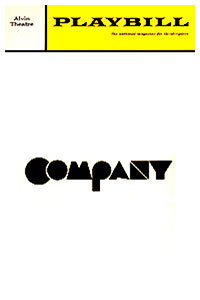“From the moment it was announced—more than a year ago—every single person I meet, no matter what their role in life is, says “COMPANY?!?! That’s one of my favorite musicals!” explains Director William Brown. “Why isn’t it done every five minutes?”
There has not been an Equity production of Stephen Sondheim and George Furth’s masterful musical at a professional theatre in the Chicagoland area since 1989 at Drury Lane Theatre, although there have been several non-Equity storefront theatre productions. Here we will explore the musical’s history and what makes it so special to some of the artists collaborating on the WT revival.

Stephen Sondheim
The genesis for Company was a series of 11 one-act plays that playwright George Furth had written in the late 1960s, all featuring a different married couple and an outsider whose presence provokes the couple in some way. When a production of the series was cancelled, Furth asked his friend Stephen Sondheim what to do with the piece. Sondheim gave the plays to director/producer Harold Prince, who observed that they would make the basis for a great musical. To focus the story, Furth and Sondheim took the outsider in each scene and made them one individual, a character named Robert (or Bob, or Bobby, or Robby, or Rob-o, depending on the friend who was talking to him). Company was Sondheim’s first great solo success for which he both wrote the lyrics and composed the music. He had taken on both roles previously on A Funny Thing Happened to the Way to the Forum (1962) and Anyone Can Whistle (1964), but the former was a throwback to the bygone vaudeville era and the latter closed after only 11 performances. For his other early career musical projects—West Side Story (1957), Gypsy (1959) and Do I Hear a Waltz? (1965)—he had only written lyrics, while others composed the music.
“It goes without saying that the score of Company is outstanding—there is so much in there. Truly, an education on every page. But when I first worked on Company in college, this was the first show where I discovered the book to be every bit as compelling as the score. George Furth‘s scenes are masterful— you know exactly who these people are in their first few lines—and each one drives forward with such momentum to its corresponding song. The show simply just works. It’s been one of my favorites for a long time.” — Ian Weinberger, Orchestral Reductions
In addition to the maturation of Sondheim’s music and lyrics, the musical also broke ground stylistically. Earlier in the century, revues had been a dominant musical form, consisting of songs and dances that were not connected in any way. Then came the “book” musical that attempted to connect its components with a rudimentary story. The success of Rodgers and Hammerstein’s Oklahoma! strengthened the appeal of the book musical and the stories connecting songs became stronger and stronger.  Company, with its collection of vignettes featuring one key character and an ensemble of others, ignores that trend. “Company does have a story, the story of what happens inside Robert,” explains Sondheim. “It just doesn’t have a chronological linear plot. Audiences kept waiting for something to happen, some incident that would lead to another that would lead to another, and were baffled when nothing did. Thus was born the ‘concept musical.’” Although there had been conceptual musicals prior to this one, none had met with as much critical and commercial praise as Company. The Broadway production opened in April 1970 and ran for almost two years, winning six Tony Awards including Best Musical, Best Music, Best Lyrics, Best Book and Best Director. A 1971 national tour followed, along with a 1972 West End production, both successful. The musical established Sondheim as the leading voice in American musical theatre at the dawn of the 1970s, a decade he would continue to dominate with his follow-up works, A Little Night Music (1973), Pacific Overtures (1976) and Sweeney Todd (1979). Part of Company’s appeal—and the sea change it ushered in has to do with its subject matter. As Sondheim remarked, “Broadway theater has been for many years supported by upper-middle-class people with upper-middle-class problems. These people really want to escape that world when they go to the theatre, and then here we are with Company talking about how we’re going to bring it right back in their faces.” Theatre as escape would certainly continue past 1970, but the amount of real life situations and scenarios represented onstage has grown exponentially in the wake of Company.
Company, with its collection of vignettes featuring one key character and an ensemble of others, ignores that trend. “Company does have a story, the story of what happens inside Robert,” explains Sondheim. “It just doesn’t have a chronological linear plot. Audiences kept waiting for something to happen, some incident that would lead to another that would lead to another, and were baffled when nothing did. Thus was born the ‘concept musical.’” Although there had been conceptual musicals prior to this one, none had met with as much critical and commercial praise as Company. The Broadway production opened in April 1970 and ran for almost two years, winning six Tony Awards including Best Musical, Best Music, Best Lyrics, Best Book and Best Director. A 1971 national tour followed, along with a 1972 West End production, both successful. The musical established Sondheim as the leading voice in American musical theatre at the dawn of the 1970s, a decade he would continue to dominate with his follow-up works, A Little Night Music (1973), Pacific Overtures (1976) and Sweeney Todd (1979). Part of Company’s appeal—and the sea change it ushered in has to do with its subject matter. As Sondheim remarked, “Broadway theater has been for many years supported by upper-middle-class people with upper-middle-class problems. These people really want to escape that world when they go to the theatre, and then here we are with Company talking about how we’re going to bring it right back in their faces.” Theatre as escape would certainly continue past 1970, but the amount of real life situations and scenarios represented onstage has grown exponentially in the wake of Company.
Tom Vendafreddo
“To put my finger on why the work is so enduring would be to acknowledge one of the most well-known tenets of aSondheim musical: character first,” says Music Director Tom Vendafreddo. “As Ben Brantley recognizes in his review of the 2006 Broadway revival, ‘It is, after all, the person who controls the music in a Sondheim production.’ So, people may not recall a specific lyric (though the melodies in Company are so memorable, they might just have luck retaining a clever rhyme or two), but they will surely remember a character like Bobby and those who surround him.”
Ericka Mac
“The first time I saw a production of Company was in college and I loved the relationship dynamics but, never having been married, I couldn’t relate to some of the sentiments. Now that I am newly divorced at 39, the piece is so much more poignant for me this time around.” — Ericka Mac, Assistant Director
“Each scene is an example of married life—the good, the bad and the ugly,” elaborates Director William Brown, “and each scene leaves Bobby more curious rather than less curious. I do not believe everyone has to go through this life two-by-two, but this is a man who thinks he does. Bobby wants something and he can’t quite figure out how to get it, and he looks to his friends to compensate. But they will never compensate for what he says he’s looking for. These people love each other and think they’re important in each other’s lives. If there are missteps or lies or pain, so be it. You get past all that and you realize you’re even closer than you thought. Life without friends hurting each other is not worth living. It makes you appreciate all the kindness, all the intimacy, all the support. But it’s not free of hurt. That’s the big lesson Bobby has to learn. You won’t get hurt if you’re the guy who walks the dog or takes the kids to the zoo or brings flowers and makes everybody laugh at dinner. That’s how not to get hurt, but it’s also how not to be alive.” ■




No comments yet.